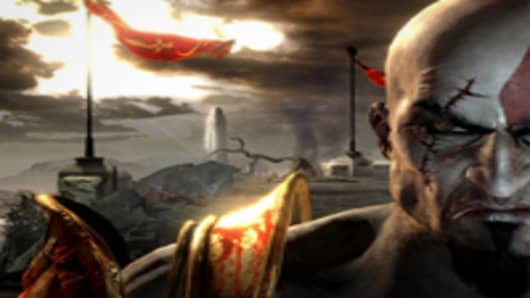When Sony released the eagerly anticipated “God of War III” this week, it wasn’t just hoping the game would be a blockbuster; it was counting on it.
The third installment in the hyper-violent, but trend setting series is one of the biggest PlayStation 3 games of the year (if not the biggest). It’s also one of the most expensive.
The game’s final price tag totaled a reported $44 million – and that’s before marketing expenses are added into the mix.
It might sound high for a video game, but for publishers working on games for Microsoft’s Xbox 360 or Sony’s PlayStation 3 these days, it’s not surprising. The price of development on console titles has skyrocketed this generation – and a hit or miss can make the difference between a good financial quarter and miserable one.
“It’s really tough in our space now if you’re not making a hit title,” said John Schappert, chief operating officer of Electronic Arts at the recent Game Developer Conference. “If you’re not making a game in the top 20 [of the monthly sales], you’re probably losing money.”
A recent study by entertainment analyst group M2 Research pegged the average cost of developing a game for this generation of consoles at between $18 million and $28 million. Larger AAA games regularly soar past that. (Take Two’s “Grand Theft Auto IV,” for instance, had a budget of $100 million – making it one of the most expensive titles ever made.)
A lot depends on the game, of course. Publishers working on titles with powerful mainstream licenses behind them can cut corners to lower cost.
“The publisher dilemma is how good is good enough for a game,” says Michael Pachter, an analyst with Wedbush Securities. “If it’s ‘Harry Potter,’ or ‘Madagascar,’ you don’t want to spend $40 million to make the game. … But if it’s ‘Call of Duty,’ you need to spend more every single time.”
To ensure long-term success, a video game company has to continually introduce new intellectual properties. Creating those is expensive, though – and if they don’t click with gamers, it’s essential to have strong existing franchises to cushion the blow. Otherwise, the consequences can be disastrous.
No publisher learned this lesson harder than Majesco , which attached its hopes to a string of new properties in the early 2000s that all failed to take off, including “Psychonauts” and “Advent Rising”. The financial ramifications were devastating – and the company barely survived, falling from $12 per share to just pennies.
EA took a similar, although much less severe drubbing in 2008, when it introduced “Mirror’s Edge” and “Dead Space”. Neither was a flop, but they weren’t exactly hits. It cost the company millions, though determining the effect on the company’s stock price is impossible, as the financial crisis was in full bloom at the time.
The impact of a failure in today’s development environment really depends on the publisher. The larger the company, the less likely you are to see ripples in the stock price. Activision-Blizzard , for instance, can absorb the cost of a poor selling game (such as last year’s “Guitar Hero: Van Halen”). But a smaller company, like Take Two Interactive, is more susceptible to fluctuations.
Games for the Nintendo Wii games are the exception to the high-spending rule. Because the framework for the system is so similar to the company’s last generation machine, it only costs $5 million or so to create a title. (Again, for major releases it can be up to five times that amount.)
Despite the expense and risk that go into making today’s video games, no one in the industry is eager to make any substantial changes. Manufacturers see a lot of earnings potential remaining in the current generation of game machines – and developers fear the cost of making a game could jump to $50 million or more in the next generation.
“I don’t think Microsoft is going to do it until they think Sony is going to do it – and I don’t think Sony is going to do it until Microsoft wants to do it,” says Pachter. “It couldn’t be green-lighted today. They couldn’t go to Howard Stringer and say ‘it’s time for the PS4’ and make a reasonable argument.”


